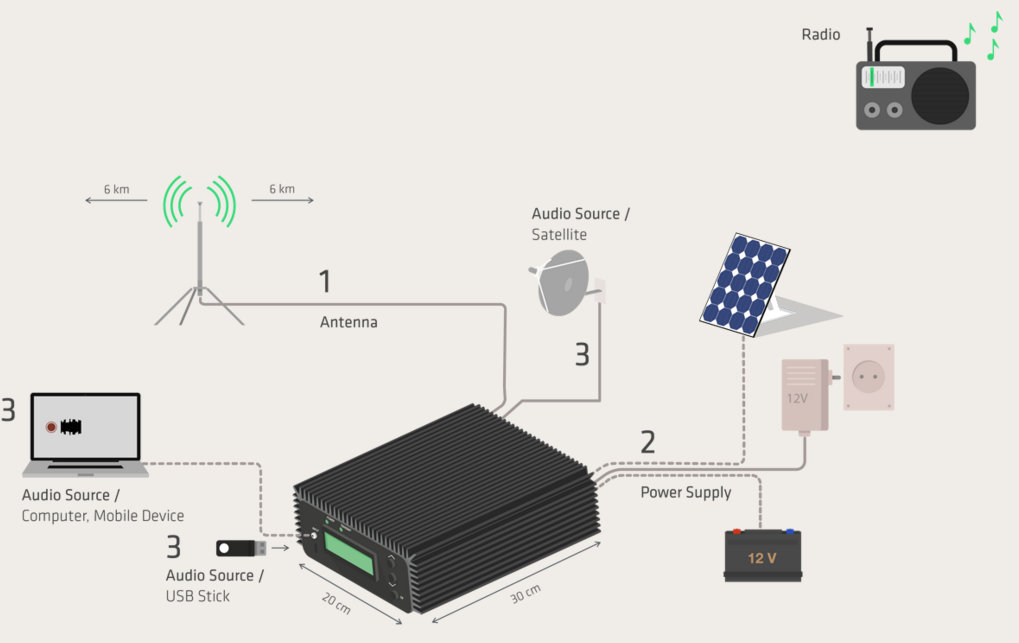(Source: NPR via Eric, WD8RIF)
Volunteer HAM operators have set up informal radio networks to connect family and friends with their loved ones in Puerto Rico. NPR’s Kelly McEvers talks to one of those volunteers, Greg Dober.

(Source: NPR via Eric, WD8RIF)
Volunteer HAM operators have set up informal radio networks to connect family and friends with their loved ones in Puerto Rico. NPR’s Kelly McEvers talks to one of those volunteers, Greg Dober.
(Source: NPR)
John Lansing is the CEO of the governing body in charge of the government-funded Voice of America news service.
He talks with Steve Inskeep about the agency’s operations under the new administration.
(Source: NPR)
It’s likely the only time you really notice one of your neighborhood broadcast and cell towers is at night when they’re lit up with conspicuous bright red lights.
Those lights help pilots see the huge metal structures that can reach 1,000 feet into the air — but they can spell disaster for birds.
In 1976 in Gun Lake, Mich., one tower killed over 2,300 birds in one night, says Caleb Putnam, who works for the Michigan Department of Natural Resources. He says for reasons scientists still can’t quite figure out, birds kept flying headlong into towers.
“If that many are dying at one night at one tower and yet there are thousands of towers across the country and as you go across the world, the numbers are staggering,” he says.
Putnam says in North America alone it’s estimated that 7 million birds smash into towers every year. But until recently scientists didn’t know why it was happening.
[…]”We were able reduce the numbers of bird fatalities on communications towers by simply extinguishing those non-flashing lights,” she says. “Those fatalities were reduced by as much as 70 percent.”[…]
(Source: NPR)
Here’s a timely reminder for all you would-be revelers out there: Be careful with your countdowns this New Year’s Eve. There will be a little extra time to bask in the glow of a retreating 2016 — or curse its name, as the case may be.
Whatever your inclination may be, one thing is certain: Before the year is out, the world’s foremost authority on time will be adding one more second to the clock.
In a bulletin released this summer, the International Earth Rotation and Reference Systems Service, or IERS, said it would be necessary to introduce a “leap second” at the end of December. Timekeepers use this added second much as leap years are used — to bring the world’s atomic clocks in sync with the Earth’s own distinctive rhythm, which in this case is determined by its rotation.
This leap second isn’t the first. Since 1971, the world has added leap seconds with some regularity — typically every two to three years — and the latest leap second was added only last year, in June.
Last year, I recorded the 2015 Leap Second via WWV–click here to read that post. Though such a subtle change, it is fun to hear that extra second added. I plan to record the full 31 meter band New Year’s Eve–hopefully, I’ll also catch the 10,000 kHz WWV Leap Second!
(Source: NPR)
Physicists at Harvard have built a radio receiver out of building blocks the size of two atoms. It is, almost certainly, the tiniest radio receiver in the world.
And since it’s a radio, it can play whatever you want to send its way, including Christmas music, as this video by the Harvard team that designed it makes clear:
Click here to view on YouTube.
NPR then quotes from The Harvard Gazette where Leah Burrows, of Harvard’s John A. Paulson School of Engineering and Applied Sciences, explains how the tiny radio works:
Radios have five basic components: a power source, a receiver, a transducer to convert the high-frequency electromagnetic signal in the air to a low-frequency current, a tuner, and a speaker or headphones to convert the current to sound.
In the Harvard device, electrons in diamond NV centers are powered, or pumped, by green light emitted from a laser. These electrons are sensitive to electromagnetic fields, including the waves used in FM radio. When NV center receives radio waves. it converts them and emits the audio signal as red light. A common photodiode converts that light into a current, which is then converted to sound through a simple speaker or headphone.
An electromagnet creates a strong magnetic field around the diamond, which can be used to change the radio station, tuning the receiving frequency of the NV centers.
Shao and Lon?ar used billions of NV centers to boost the signal, but the radio works with a single NV center, emitting one photon at a time, rather than a stream of light.
The radio is extremely resilient, thanks to the inherent strength of diamond. The team successfully played music at 350 degrees Celsius — about 660 Fahrenheit.[…]
SWLing Post contributor, Paul Walker, is not only a shortwave listener, he’s also a broadcaster.
Paul works at community radio station KIYU in Galena, Alaska. At my request, Paul has kindly shared a few photos of his workplace with us.


Paul also sent this short video at the mic of KIYU:
http://youtu.be/VjTWKpXIHGU
Very cool, Paul! You certainly have a lot of translators to list in your station ID–no doubt, these are the many sites that serve your communities.
Thanks for sharing a little of your world at KIYU!
If you’d like to try hear Paul on the air, check out the KIYU home page.

(Source: NPR)
A non-profit organization in Berlin has invented a small portable transmitter that can download satellite signals and rebroadcast them on FM for Syrians to listen to on their car or household radios.
If this story sounds familiar, it’s because we posted something about the organization a few weeks ago.